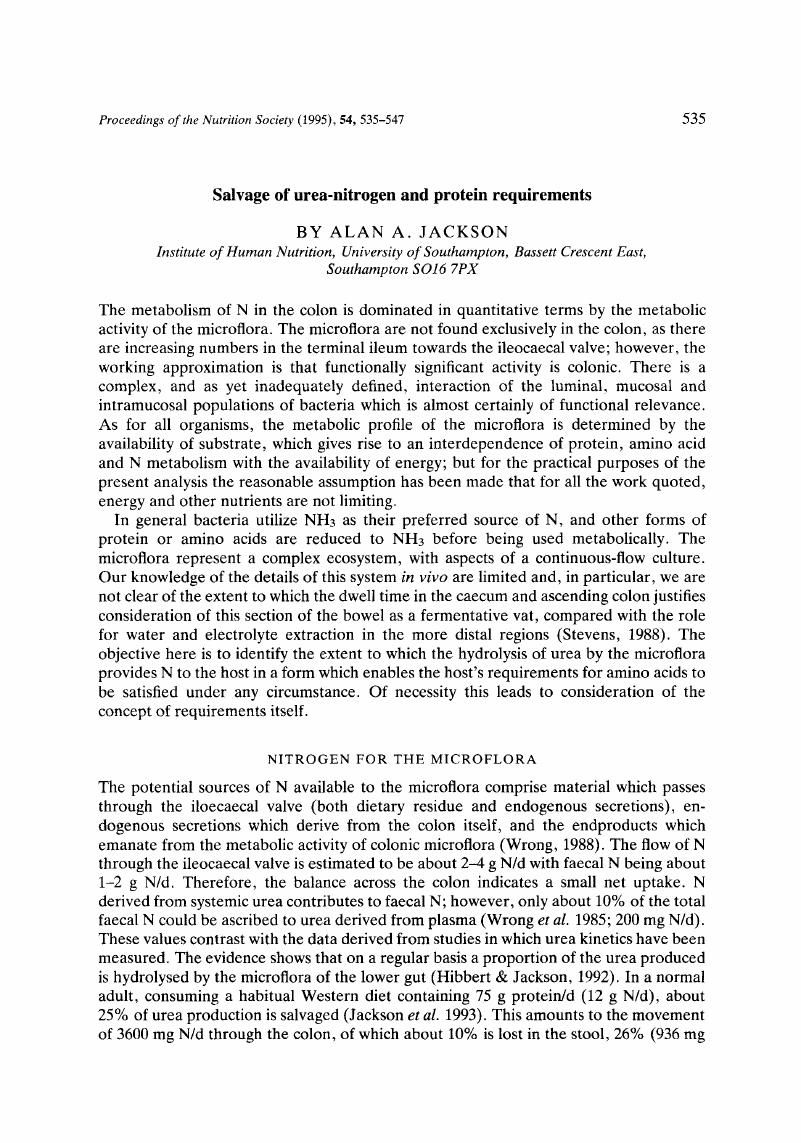Crossref Citations
This article has been cited by the following publications. This list is generated based on data provided by Crossref.
Steinbrecher, HA
Griffiths, DM
and
Jackson, AA
1996.
Urea production in normal breast‐fed infants measured with primed/intermittent oral doses of [15N,15N]urea.
Acta Paediatrica,
Vol. 85,
Issue. 6,
p.
656.
el-Khoury, A. E.
Ajami, A. M.
Fukagawa, N. K.
Chapman, T. E.
and
Young, V. R.
1996.
Diurnal pattern of the interrelationships among leucine oxidation, urea production, and hydrolysis in humans.
American Journal of Physiology-Endocrinology and Metabolism,
Vol. 271,
Issue. 3,
p.
E563.
McClelland, Irene S. M.
and
Jackson, Alan A.
1996.
Urea kinetics in healthy young women: minimal effect of stage of menstrual cycle, contraceptivepill and protein intake.
British Journal of Nutrition,
Vol. 76,
Issue. 2,
p.
199.
Jackson, Alan A.
Persaud, Chandarika
Meakins, Tracey S.
and
Bundy, Rafe
1996.
Urinary Excretion of 5-L-Oxoproline (Pyroglutamic Acid) Is Increased in Normal Adults Consuming Vegetarian or Low Protein Diets.
The Journal of Nutrition,
Vol. 126,
Issue. 11,
p.
2813.
1996.
Abstracts of Communications.
Proceedings of the Nutrition Society,
Vol. 55,
Issue. 3,
p.
213A.
Torrallardona, David
Harris, C. Ian
and
Fuller, Malcolm F.
1996.
Microbial amino acid synthesis and utilization in rats: the role of coprophagy.
British Journal of Nutrition,
Vol. 76,
Issue. 5,
p.
701.
Cummings, J.H.
and
Macfarlane, G.T.
1997.
Collaborative JPEN‐Clinical Nutrition Scientific Publications Role of intestinal bacteria in nutrient metabolism.
Journal of Parenteral and Enteral Nutrition,
Vol. 21,
Issue. 6,
p.
357.
Cummings, J.H.
and
Macfarlane, G.T.
1997.
Role of intestinal bacteria in nutrient metabolism.
Clinical Nutrition,
Vol. 16,
Issue. 1,
p.
3.
el-Khoury, A. E.
Forslund, A.
Olsson, R.
Branth, S.
Sjodin, A.
Andersson, A.
Atkinson, A.
Selvaraj, A.
Hambraeus, L.
and
Young, V. R.
1997.
Moderate exercise at energy balance does not affect 24-h leucine oxidation or nitrogen retention in healthy men.
American Journal of Physiology-Endocrinology and Metabolism,
Vol. 273,
Issue. 2,
p.
E394.
Gausserès, Nicolas
Mahé, Sylvain
Benamouzig, Robert
Luengo, Catherine
Ferriere, Francoise
Rautureau, Jacques
and
Tomé, Daniel
1997.
[15N]-Labeled Pea Flour Protein Nitrogen Exhibits Good Ileal Digestibility and Postprandial Retention in Humans.
The Journal of Nutrition,
Vol. 127,
Issue. 6,
p.
1160.
McClelland, Irene S. M.
Persaud, Chandarika
and
Jackson, Alan A.
1997.
Urea kinetics in healthy women during normal pregnancy.
British Journal of Nutrition,
Vol. 77,
Issue. 2,
p.
165.
Lenton, C.
Ali, Z.
Persaud, C.
and
Jackson, A.A.
1998.
Infants in Trinidad excrete more 5-L-oxoproline (L-pyroglutamic acid) in urine than infants in England: an environmental not ethnic difference.
British Journal of Nutrition,
Vol. 80,
Issue. 1,
p.
51.
Fuller, Malcolm F.
and
Reeds, Peter J.
1998.
NITROGEN CYCLING IN THE GUT.
Annual Review of Nutrition,
Vol. 18,
Issue. 1,
p.
385.
Forslund, Anders H.
Hambraeus, Leif
Olsson, Roger M.
El-Khoury, Antoine E.
Yu, Yong-Ming
and
Young, Vernon R.
1998.
The 24-h whole body leucine and urea kinetics at normal and high protein intakes with exercise in healthy adults.
American Journal of Physiology-Endocrinology and Metabolism,
Vol. 275,
Issue. 2,
p.
E310.
Meakins, Tracey S.
Persaud, Chandarika
and
Jackson, Alan A.
1998.
Dietary Supplementation with L-Methionine Impairs the Utilization of Urea-Nitrogen and Increases 5-L-Oxoprolinuria in Normal Women Consuming a Low Protein Diet , ,.
The Journal of Nutrition,
Vol. 128,
Issue. 4,
p.
720.
Sarraseca, A.
Milne, E.
Metcalf, M. J.
and
Lobley, G. E.
1998.
Urea recycling in sheep: effects of intake.
British Journal of Nutrition,
Vol. 79,
Issue. 1,
p.
79.
Evenepoel, Pieter
Claus, Dirk
Geypens, Benny
Hiele, Martin
Geboes, Karen
Rutgeerts, Paul
and
Ghoos, Yvo
1999.
Amount and fate of egg protein escaping assimilation in the small intestine of humans.
American Journal of Physiology-Gastrointestinal and Liver Physiology,
Vol. 277,
Issue. 5,
p.
G935.
Metges, Cornelia C
Petzke, Klaus J
El-Khoury, Antoine E
Henneman, Lidewij
Grant, Ian
Bedri, Shahinaze
Regan, Meredith M
Fuller, Malcolm F
and
Young, Vernon R
1999.
Incorporation of urea and ammonia nitrogen into ileal and fecal microbial proteins and plasma free amino acids in normal men and ileostomates.
The American Journal of Clinical Nutrition,
Vol. 70,
Issue. 6,
p.
1046.
Badaloo, Asha
Boyne, Michael
Reid, Marvin
Persaud, Chandarika
Forrester, Terrence
Millward, D. Joe
and
Jackson, Alan A.
1999.
Dietary Protein, Growth and Urea Kinetics in Severely Malnourished Children and During Recovery.
The Journal of Nutrition,
Vol. 129,
Issue. 5,
p.
969.
Metges, Cornelia C.
El-Khoury, Antoine E.
Henneman, Lidewij
Petzke, Klaus J.
Grant, Ian
Bedri, Shahinaze
Pereira, Paulo P.
Ajami, Alfred M.
Fuller, Malcolm F.
and
Young, Vernon R.
1999.
Availability of intestinal microbial lysine for whole body lysine homeostasis in human subjects.
American Journal of Physiology-Endocrinology and Metabolism,
Vol. 277,
Issue. 4,
p.
E597.



